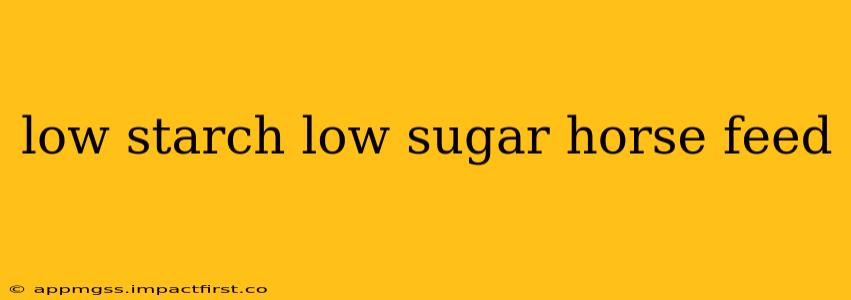Feeding your horse a diet low in starch and sugar is crucial for maintaining their health and well-being, particularly for those prone to conditions like insulin resistance, equine metabolic syndrome (EMS), or Cushing's disease. However, finding the right feed can be challenging. This comprehensive guide will delve into the nuances of low starch, low sugar horse feed, helping you make informed choices for your equine companion.
What is Low Starch, Low Sugar Horse Feed?
Low starch, low sugar horse feed is formulated to minimize the intake of rapidly digestible carbohydrates. These carbohydrates, primarily starch and sugar, can cause spikes in blood glucose levels, leading to various health problems in susceptible horses. Instead, these feeds often emphasize sources of fiber, such as high-quality hay and carefully selected grains. The goal is to provide sustained energy release without the negative consequences of rapid sugar absorption.
What are the Benefits of a Low Starch, Low Sugar Diet for Horses?
The benefits of a low starch, low sugar diet extend beyond simply preventing disease. A well-balanced diet can:
- Improve Insulin Sensitivity: Reducing starch and sugar intake helps regulate insulin levels, improving insulin sensitivity and reducing the risk of EMS and laminitis.
- Promote Healthy Weight Management: Lower calorie density from reduced sugars can aid in weight management, especially important for horses prone to obesity.
- Enhance Digestive Health: High-fiber feeds support a healthy gut microbiome, promoting efficient digestion and nutrient absorption.
- Increase Energy Levels: While counterintuitive, slow-releasing energy from fiber provides sustained energy throughout the day, avoiding the energy crashes associated with high-sugar diets.
- Improve Coat Quality: A balanced diet often results in a healthier, shinier coat.
What are the Ingredients to Look for in Low Starch, Low Sugar Horse Feed?
When selecting a low starch, low sugar feed, look for these key ingredients:
- High-Quality Forage: This should form the foundation of your horse's diet. Good quality hay (grass or alfalfa depending on individual needs) is essential.
- Low-Glycemic Index Grains: If grains are included, opt for those with a lower glycemic index, such as oats (in moderation).
- Fiber Sources: Feeds rich in fiber, such as beet pulp and soy hulls, help regulate blood sugar and promote gut health.
- Added Vitamins and Minerals: Ensure the feed provides a balanced supply of essential vitamins and minerals. It's a good practice to discuss your horse's supplementation needs with your veterinarian.
How Much Low Starch, Low Sugar Feed Should I Give My Horse?
The amount of feed required varies based on your horse's age, weight, activity level, and individual metabolic needs. It's vital to follow feeding guidelines provided by the feed manufacturer and consult with your veterinarian or an equine nutritionist. They can help you tailor a feeding plan that accurately addresses your horse's specific requirements. Always remember to prioritize good quality hay as the base of their diet.
What are the signs of a horse with metabolic issues related to high starch/sugar diets?
Horses with metabolic issues related to high starch/sugar diets might exhibit several symptoms including weight gain despite decreased appetite, laminitis (inflammation of the laminae in the hoof), increased urination, excessive drinking, and a generally poor hair coat. Consult your veterinarian if you observe any of these symptoms.
What are some alternative feeding strategies for horses with metabolic conditions?
Alternative feeding strategies for horses with metabolic conditions can include increased hay intake, portion-controlled feeding, and the use of specific supplements under veterinary guidance. These strategies aim to manage blood glucose levels and improve overall health.
Is all low-sugar horse feed the same?
No, all low-sugar horse feed is not the same. The quality of ingredients, the processing methods, and the overall nutritional profile vary significantly between brands and formulations. It’s crucial to compare labels and choose a feed that specifically meets your horse's dietary needs and health condition.
How can I transition my horse to a low-starch, low-sugar diet?
Transitioning your horse to a low-starch, low-sugar diet should be done gradually to avoid digestive upset. A slow and steady change is recommended over several weeks, slowly increasing the proportion of the new feed while decreasing the old. Monitor your horse carefully for any adverse reactions during this period.
By carefully selecting a low starch, low sugar horse feed and adopting appropriate feeding practices, you can significantly contribute to your horse's overall health and well-being. Remember to consult with your veterinarian or an equine nutritionist to create a personalized feeding plan that is tailored to your horse's specific needs and health status. Regular monitoring of your horse's weight, body condition, and behavior is also essential to ensure the diet remains effective and appropriate.
